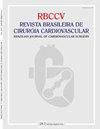Ebstein畸形外科治疗的早期和长期疗效
IF 1.1
4区 医学
Q4 CARDIAC & CARDIOVASCULAR SYSTEMS
Revista Brasileira De Cirurgia Cardiovascular
Pub Date : 2019-12-01
DOI:10.21470/1678-9741-2018-0333
引用次数: 10
摘要
目的评价Ebstein畸形手术矫正的早期和远期疗效。方法回顾性分析2000年1月至2016年7月在我院连续行Ebstein畸形手术修复的62例患者。评估以下长期结果:生存、再手术、三尖瓣反流和术后右心室功能障碍。结果46例(74.2%)患者行瓣膜修复,其中12例采用Da Silva椎体重建;11例(17.7%)患者行三尖瓣置换术;单心室缓解1例(1.6%);四个(6.5%)病人的一个半心室修复。患者手术时平均年龄20.5±14.9岁,男性占46.8%。平均随访时间8.8±6年。30天死亡率为8.06%,1年和10年生存率均为91.9%。62例患者中有11例(17.7%)因三尖瓣反流需要后期再手术,平均时间为首次手术后7.1±4.9年。结论根据我们的经验,手术治疗Ebstein畸形的长期结果显示出可接受的生存率和低的再干预发生率。本文章由计算机程序翻译,如有差异,请以英文原文为准。
Early and Long-Term Outcomes of Surgical Treatment of Ebstein’s Anomaly
Objective This study aimed to evaluate Ebstein’s anomaly surgical correction and its early and long-term outcomes. Methods A retrospective analysis of 62 consecutive patients who underwent surgical repair of Ebstein’s anomaly in our institution from January 2000 to July 2016. The following long-term outcomes were evaluated: survival, reoperations, tricuspid regurgitation, and postoperative right ventricular dysfunction. Results Valve repair was performed in 46 (74.2%) patients - 12 of them using the Da Silva cone reconstruction; tricuspid valve replacement was performed in 11 (17.7%) patients; univentricular palliation in one (1.6%) patient; and the one and a half ventricle repair in four (6.5%) patients. The patients’ mean age at the time of surgery was 20.5±14.9 years, and 46.8% of them were male. The mean follow-up time was 8.8±6 years. The 30-day mortality rate was 8.06% and the one and 10-year survival rates were 91.9% both. Eleven (17.7%) of the 62 patients required late reoperation due to tricuspid regurgitation, in an average time of 7.1±4.9 years after the first procedure. Conclusion In our experience, the long-term results of the surgical treatment of Ebstein's anomaly demonstrate an acceptable survival rate and a low incidence of reinterventions.
求助全文
通过发布文献求助,成功后即可免费获取论文全文。
去求助
来源期刊

Revista Brasileira De Cirurgia Cardiovascular
CARDIAC & CARDIOVASCULAR SYSTEMS-SURGERY
CiteScore
2.10
自引率
0.00%
发文量
176
审稿时长
20 weeks
期刊介绍:
Brazilian Journal of Cardiovascular Surgery (BJCVS) is the official journal of the Brazilian Society of Cardiovascular Surgery (SBCCV). BJCVS is a bimonthly, peer-reviewed scientific journal, with regular circulation since 1986.
BJCVS aims to record the scientific and innovation production in cardiovascular surgery and promote study, improvement and professional updating in the specialty. It has significant impact on cardiovascular surgery practice and related areas.
 求助内容:
求助内容: 应助结果提醒方式:
应助结果提醒方式:


